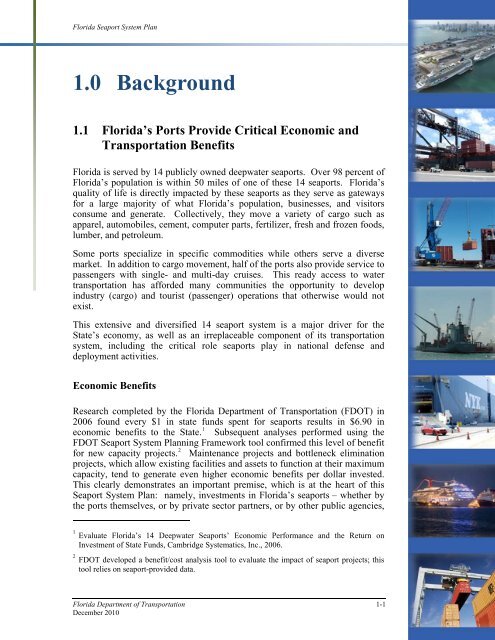Florida Seaport System Plan - SeaCIP
Florida Seaport System Plan - SeaCIP
Florida Seaport System Plan - SeaCIP
Create successful ePaper yourself
Turn your PDF publications into a flip-book with our unique Google optimized e-Paper software.
<strong>Florida</strong> <strong>Seaport</strong> <strong>System</strong> <strong>Plan</strong><br />
1.0 Background<br />
1.1 <strong>Florida</strong>’s Ports Provide Critical Economic and<br />
Transportation Benefits<br />
<strong>Florida</strong> is served by 14 publicly owned deepwater seaports. Over 98 percent of<br />
<strong>Florida</strong>’s population is within 50 miles of one of these 14 seaports. <strong>Florida</strong>’s<br />
quality of life is directly impacted by these seaports as they serve as gateways<br />
for a large majority of what <strong>Florida</strong>’s population, businesses, and visitors<br />
consume and generate. Collectively, they move a variety of cargo such as<br />
apparel, automobiles, cement, computer parts, fertilizer, fresh and frozen foods,<br />
lumber, and petroleum.<br />
Some ports specialize in specific commodities while others serve a diverse<br />
market. In addition to cargo movement, half of the ports also provide service to<br />
passengers with single- and multi-day cruises. This ready access to water<br />
transportation has afforded many communities the opportunity to develop<br />
industry (cargo) and tourist (passenger) operations that otherwise would not<br />
exist.<br />
This extensive and diversified 14 seaport system is a major driver for the<br />
State’s economy, as well as an irreplaceable component of its transportation<br />
system, including the critical role seaports play in national defense and<br />
deployment activities.<br />
Economic Benefits<br />
Research completed by the <strong>Florida</strong> Department of Transportation (FDOT) in<br />
2006 found every $1 in state funds spent for seaports results in $6.90 in<br />
economic benefits to the State. 1<br />
Subsequent analyses performed using the<br />
FDOT <strong>Seaport</strong> <strong>System</strong> <strong>Plan</strong>ning Framework tool confirmed this level of benefit<br />
for new capacity projects. 2<br />
Maintenance projects and bottleneck elimination<br />
projects, which allow existing facilities and assets to function at their maximum<br />
capacity, tend to generate even higher economic benefits per dollar invested.<br />
This clearly demonstrates an important premise, which is at the heart of this<br />
<strong>Seaport</strong> <strong>System</strong> <strong>Plan</strong>: namely, investments in <strong>Florida</strong>’s seaports – whether by<br />
the ports themselves, or by private sector partners, or by other public agencies,<br />
1<br />
Evaluate <strong>Florida</strong>’s 14 Deepwater <strong>Seaport</strong>s’ Economic Performance and the Return on<br />
Investment of State Funds, Cambridge <strong>System</strong>atics, Inc., 2006.<br />
2<br />
FDOT developed a benefit/cost analysis tool to evaluate the impact of seaport projects; this<br />
tool relies on seaport-provided data.<br />
<strong>Florida</strong> Department of Transportation 1-1<br />
December 2010
















